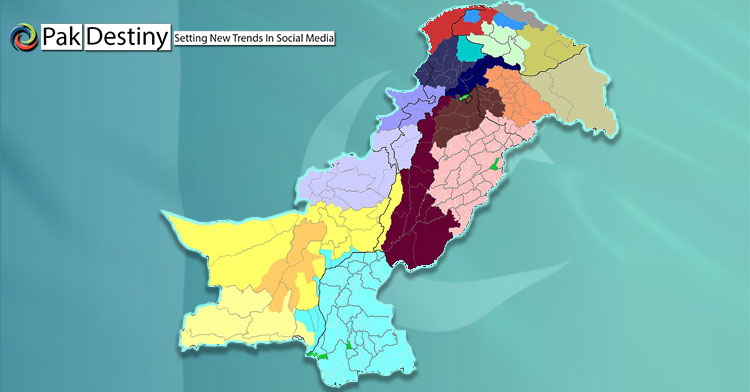
By Ismaeel Qasim
Pakistan is a federation with constitutionally mandated power sharing agreement between state and provinces. It is is home to several ethnic and linguistic entities and even with such diversity, it falls behind its neighboring countries in the number of administrative units that it has. At a time where this 5th most populated country of the world has merely 4 provinces, 2 autonomous territories and 1 federally administered territory, China and India have 34 and 36 administrative units respectively. Even if you move further away in the globe, other examples are also present where developed nations such as Turkey and US have 81 provinces & 50 states respectively.
There have been longstanding calls for new provinces due to several
reasons but they have not bore fruit as yet. Proposals include Punjab being further divided into Saraiki and Bahawalpur units. Sindh to have 3 divisions including Karachi, Urdu Speaking and Mohajir. KPK can have another unit in Hazara and Balochistan can be divided around the Pashtun belt. Though the fact cannot be ignored that it is very important issue, potentially an
existential issue, and hence must be analyzed and debated upon fully
before reaching any final conclusion.
Some of the major issues as a result of which this debate surfaced
included the difficulty of governing larger provinces, uneven provincial make-up, inefficient local administration, biased economic spending,
grievances of provincial minorities, lack of nationally representative political parties, a strengthened federation and possibility of substantial national
integration.
Residents of Kot Sabzal, a small town in Rahim Yar Khan district of Punjab, have to travel 634km to get to their provincial capital, Lahore, whenever they need to find themselves present there. Situation is even worse in Balochistan, where the minimum distance between the coastal town of Jiwani and the provincial capital, Quetta, is 980km. This burdened distance factor when coupled with poor law and order situation, minimal check and balance on all fronts, difficulties the public has to face in trying to benefit from administration or when they want to get a hold of authorities, are just a few of the problems in governing large provinces. An example in this regard is of Balochistan, which being the largest province suffers the most from this problem.
Uneven provincial make-up is another issue as a result of which the demand for new provinces is made. Punjab happens to be the largest province in terms of population and hence it secures dominance in political, economic and administrative affairs. Not only does it have the most seats in National Assembly but it also enjoys the largest share in NFC and other resources. As a result, it is more economically developed than the rest of Pakistan. Punjab’s average HDI in 2018 stood at 0.732 in comparison to Balochistan which had a meager 0.421 HDI. Such factors lead to grievances of smaller provinces.
When we talk about the disadvantages of larger provinces, another factor that is highlighted happens to the inefficiency of local administration. It is hard to believe but there was no local bodies structure till 2015. Once it was forced by SC to hold LB elections, there was no administrative authority to take up the responsibility and even raising the funds for it also became an issue. This further pointed towards the administrative flaws and
reinforced the calls for new provinces.
Even within the provinces, there are divisions that are aggravating this problem. Biased economic growth sits at the top in this list. Central Punjab is more industrialized and developed than South Punjab that is a more agricultural zone. Talking about Sindh, Karachi is much more developed than rest of the Sindh. Same is the case with the capitals of other provinces that end up getting more reward and favor. More so, extra focus is laid on already developed areas owing to their political significance. The HDI differences in this regard show a staggering difference even between the cities of the same provinces. For instance Lahore has a promising 0.877 HDI whereas Rajanpur is left with question marks at a mere 0.506 HDI. Karachi enjoys an HDI as high as 0.854 whereas Thar with its disparities is left to suffer at 0.227 HDI.
Add to all this the grievances of provincial minorities that suffer economic and political marginalization by the majority. Lack of nationally representative political parties also fuels violent separatist movements and leads to further isolation. There is no platform to address this unfairness as national and provincial assemblies are also dominated by the majority groups. Another important factor that needs to be considered here is the strength of federation. Having smaller provinces will lead to greater role of federation that eventually eliminates separatist tendencies and promotes National Integration.
To conclude, it can be stated that PTI needs to materialise its mandate of making new provinces in Pakistan. It will help in redressing grievances and concerns of provincial minorities and at the same time lead to more economic development. Even distribution of finances throughout the country will help in increased administrative efficiency and improved law and order situation. We should take an example of India that is a progressing country and a technological hub at present. It started making new provinces right after independence. The case was opposite in Pakistan which focused on a failed one unit policy which eventually resulted in an embarrassing debacle of East Pakistan. Pak Destiny






Bayshak
South punjab